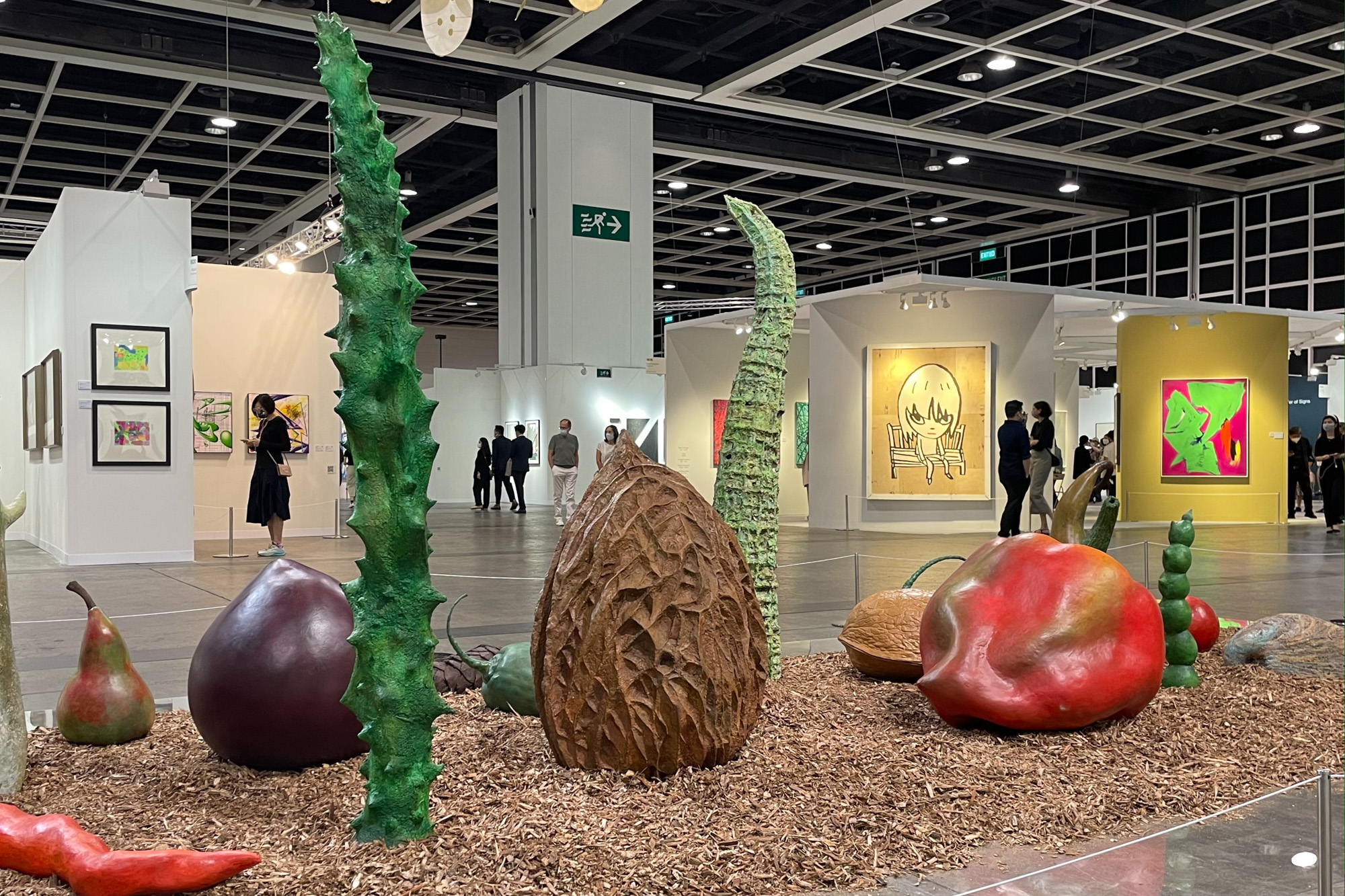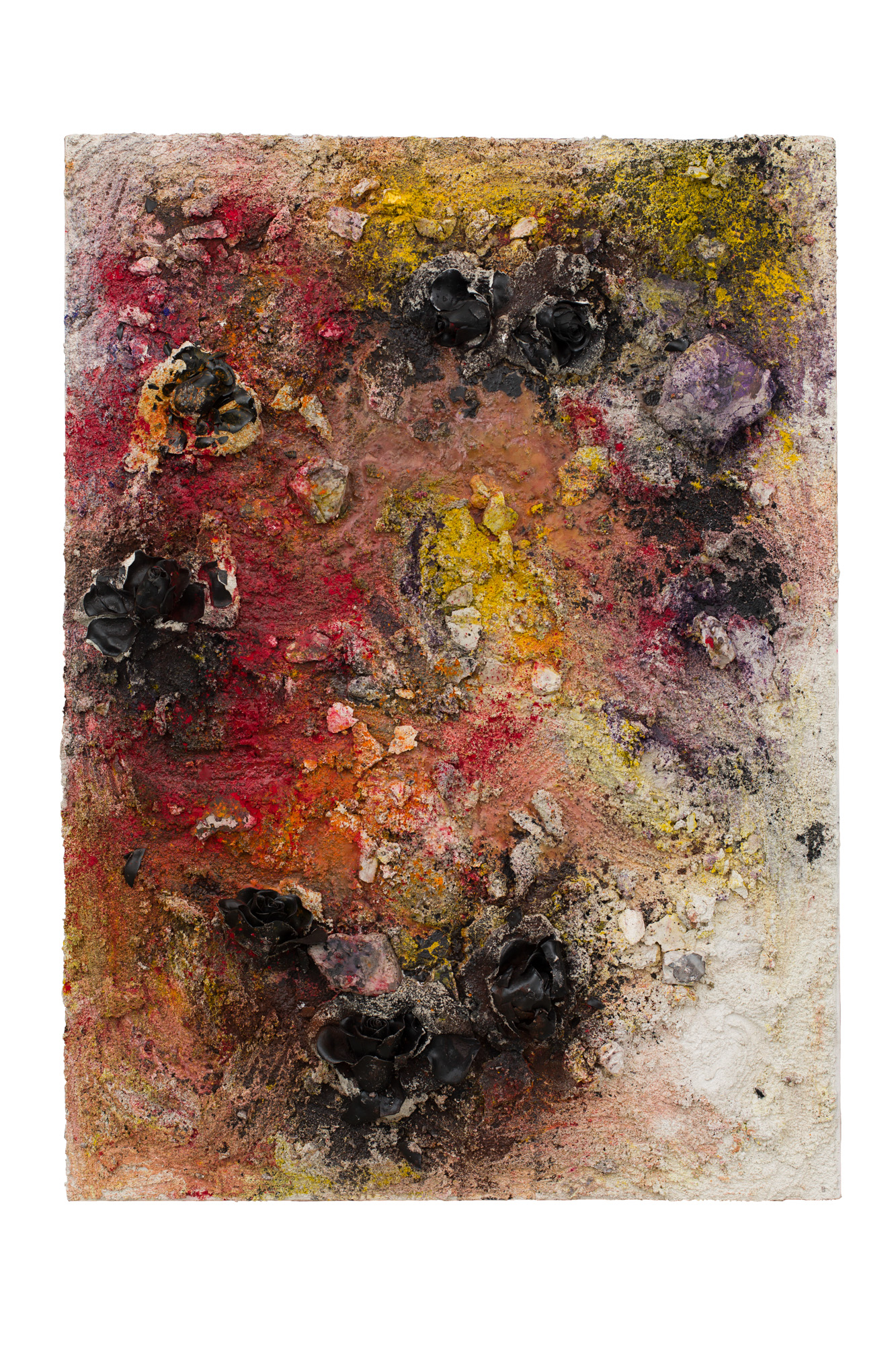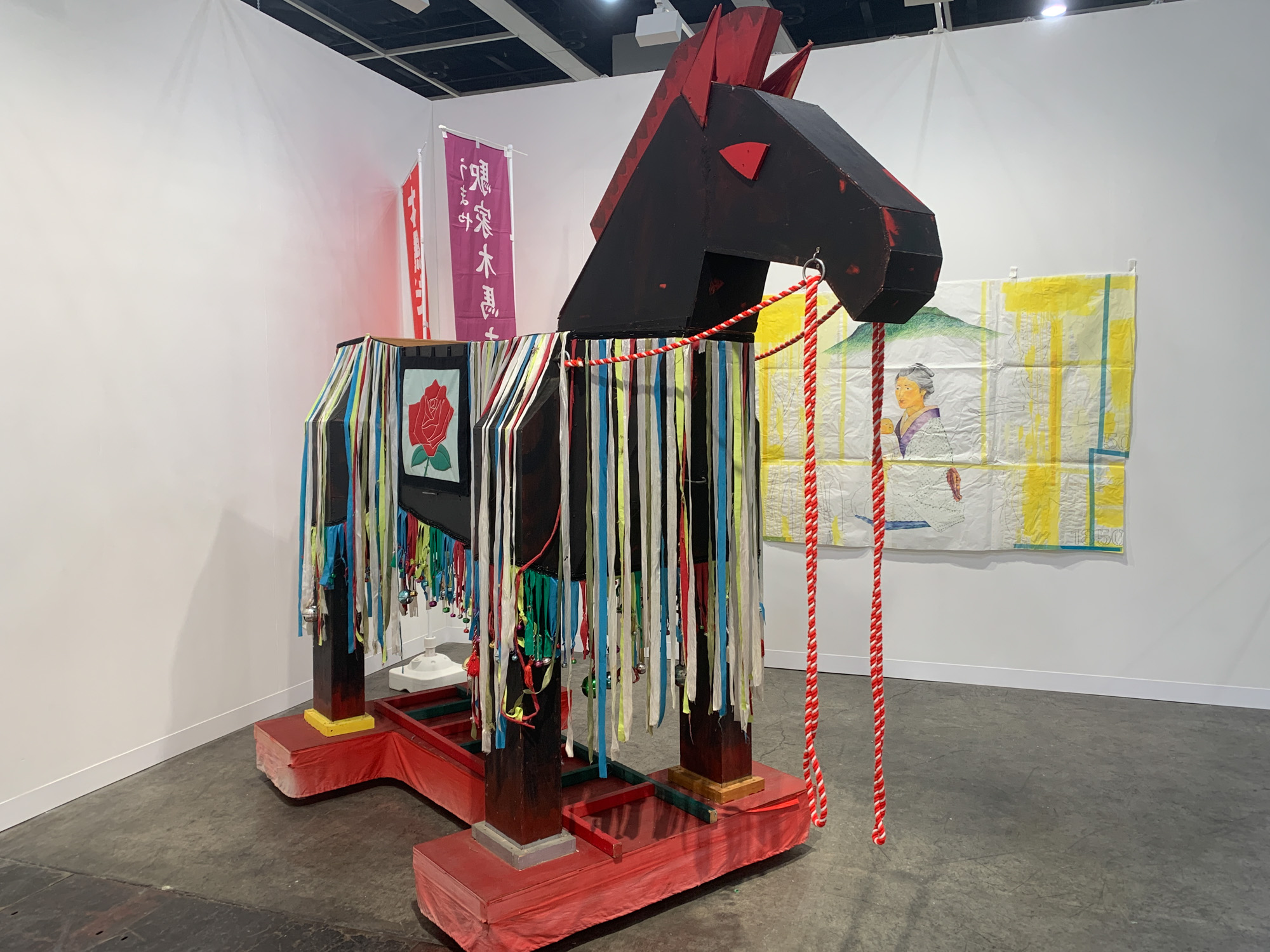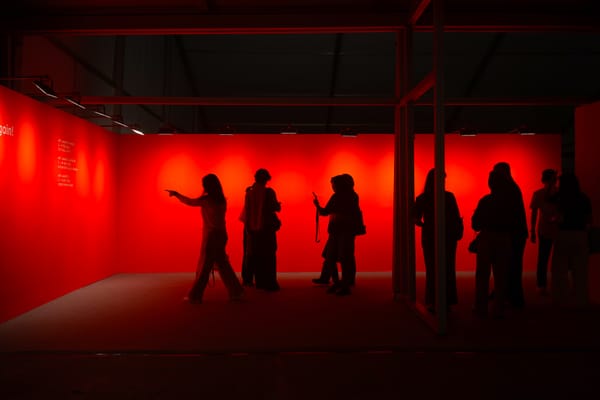Market
Highlights at Art Basel Hong Kong 2022


Postponed from March, the 2022 edition of Art Basel Hong Kong (ABHK) took off on May 25, leading the re-emergence of large-scale events in Hong Kong as the city recovers from its devastating fifth pandemic wave. Taking up three halls of the Hong Kong Convention and Exhibition Centre (HKCEC) are 130 galleries from 28 countries and territories (with 76 of these participants sending artworks only and no staff for their satellite booths). As in last year, there are three sectors: Galleries, the main portion of the fair; Insights, with focused presentations on artists of historical importance in the Asia-Pacific region; and Discoveries, for emerging artists. Here are AAP’s highlights.

ABHK’s private view on May 25 saw crowds of businessmen and women in smart or flamboyant attire flock to the HKCEC’s expansive first floor. At the booths of established local and international galleries placed in the center of the fair, crowds impatiently yearned to glance at and take selfies with the works of big names in the art world.
On the outskirts however, small booths carry less widely recognized artists. Presented by Istanbul’s Dirimart are the awe-inspiring works of Ebru Uygun, both carrying identical titles, Untitled (2022). These mixed-media-on-canvas pieces widened my eyes and halted my footsteps as I strolled through representational paintings and large sculptures. Indexing the artist’s gestures as she shifted plaster around the canvas, the paintings evoke chaos and destruction. Blackened and shattered roses and rubble litter the surface, where the artist crushed the elements with her feet. Although Uygun aims to explore materiality and form in her works, one can’t help but infer allusions to the political and socioeconomical conditions of Turkey, which reverberate with the state of Hong Kong.
Another artist who’s making noise is Gallerie Urs Meile Beijing’s Cao Yu. Art as a form of personal expression is taken literally with Cao, who used her own hair as threads to sew Chinese characters into the canvases of her two works Everything is Left Behind XI (2020) and Everything is Left Behind XII (2020). The diary-like entries describe boys poking fun at a girl for being stupid for getting hurt and feeling pain. Cao challenges gender stereotypes and the prejudices of Chinese society with her works, making her a must see in today’s tense climate. ANGELIQUE SANTOS

Throughout ABHK are artists challenging how we understand history, and who present alternative ways of perceiving time. Yoshio Shirakawa’s gigantic wooden horse caught my attention at the booth of Rin Art Association. An accompanying video explains how the horse is paraded through the streets of Maebashi as members of the local community chant “Mokuba da, mokuba da, da, da” (wooden horse, wooden horse) as part of an annual festival. According to Shirakawa, the ritual began in the Meiji era as a form of prayer for protection against natural disasters and disease. As the video progresses, however, it becomes clear that this story of the festival’s origins is fictional, based only loosely on historical events. The narrative extends into an imagined account of how a Swiss businessman who heard shouts of “Da, da, da” at the parade triggered the emergence of the Dada movement upon his return to Europe—a sly twist on art history that reflects Shirakawa’s long-running interest in Dada as a sculptor and as a researcher.
At the booth of gb agency, Cally Spooner’s sculptures and video got me thinking about how we commodify our time. I drew parallels between a metal sculpture cast from an eroded lump of soap that was held for 12 hours by a man whom Spooner had hired with our sometimes absurd occupational pursuits. And if our time and lives can be sold, what makes us different to, say, a good, like a pear that you can buy at a supermarket? In a performance score displayed on a wall, Spooner writes, “solo body is arranging itself into a composition modeled on advertised food.” Nearby, the video of DEAD TIME (Maggie’s Solo) (2021) shows a woman moving frantically and then holding static poses as her chest rises and falls increasingly noticeably; a speaker intermittently sounds loud beeps, reminding me of the beep tests of PE classes that test speed and endurance. As the artist suggests, in an era that prizes efficiency, we are “simultaneously vital and corpse-like.” CHLOE CHU

I became interested in the many ways artists represent ideas of consciousness, reflecting on the technological and societal transformations of the late 20th and early 21st centuries. In the Insights sector, Axel Vervoodt is featuring Norio Imai, a member of the Gutai Artists Association, whose experimental, formalist works from the 1960s are white-painted canvases with bulbous protrusions and circular holes. More personally emotive are his ongoing Daily Portraits (1979– ) series of polaroid selfies—one year’s worth is shown stacked in its own plexiglass box—as the artist portrays himself captured in time and changing technologies. At David Kordansky we see a pairing of Los Angeles-based abstract artists, including painter Lesley Vance, and Anna Zemánková, who used art as her personal therapy while living in Prague during the 1950s and ’60s. Working in the pre-dawn hours in a state of semi-wakefulness, Zemánková made biomorphic drawings that resemble botanical illustrations and Moravian folk designs, tapping into ideas of the unconscious. Finally at Hauser & Wirth is Pierre Huyghe’s Mind’s Eye (S) (2022), a sculpture made from deep-learning software’s readings of a human brain picturing an object, while Tetsumi Kudo’s figure of a head in a cage, Meditation Between Memory and Future (1978), weighs two balls of thread, one clean and the other soiled, while the plastic flowers above the cage have melted, suggesting the ways that our conscious minds are also prisoners of history and tragedy. HG MASTERS

Bangkok-based artist Dusadee Huntrakul’s solo presentation at Bangkok Citycity Gallery showcases his latest series titled A Lens to See the World Through (all works 2022), which consists of ceramics, photographs, bronze sculptures, and color-pencil drawings. Placed on top of air-conditioner condensers, the works depict common creatures found in our living spaces. House geckos, fungi, and bacteria are captured with hyperrealistic drawings as well as imaginative forms, hinting at mundane wonders. The booth exudes warmth and intimacy, reminding us of our connection to the organic world even within the sanitized walls of the exhibition center.
Similarly, at the booth of Pifo Gallery, Kang Haitao depicts illusory visions with familiar impressions of branches, houses, and open fields. The blurry, acrylic paintings record without datafication or reflection, inviting us to take a softer focus and to see our world beyond its positive space. PETER CHUNG

Vegetables and fruits took center-stage at this year’s fair as larger-than-life chili, capsicum, and pear—among other edible produce—protrude from the literal center of the show floor in Ming Fay’s new installation, Garden of Life (2022). Yet, the most thoughtful approaches to nature were found in the booths that occupy the floorplan’s peripheries. Mexico City-based MAIA Contemporary’s presentation of Cisco Jiménez’s “Totems of a Lost Generation” introduced the veteran Latin American artist to Asia with a new series of vibrant paintings and sculptures that depict retro technologies like boomboxes and record players as cultural debris that have reintegrated with the minerals of the earth. Once highly desired commodities that represented progress, these objects’ return to the soil signals our rapidly changing lifestyles, inevitable decomposition, and a generation’s collective disillusionment with the future. Evocative of orographic diagrams and fossils, the works collapse the binary of nature and culture.
Often the most tantalizing mushroom is also the most poisonous. Fan Xi’s “Temptation” series at the booth of Beijing-based CLC Gallery Venture perceive nature as both alluring and dangerous. Stainless steel and paper sculptures of tropical plants were writhing, slithering, and palpitating across the floor and all over the walls, seemingly possessing consciousness and personalities. “Temptation” was the result of Fan’s residency in Pulau Dinawan, Malaysia, where an inaccessible atoll became too irresistible for her to not explore: “After being tormented by the desire for about a week, I finally threw myself into this trap.” The sculptures were created by printing the images of plants that the artist took during her visit to the atoll onto steel and paper, which were then shaped into voluminous forms, restoring her subject’s three-dimensionality via the two-dimensional medium of photography. Both Jiménez’s and Fan’s series are a reminder of our place in nature. The fair proves that the investigation on the complicated human/nonhuman relationship is the art world’s ongoing pursuit. NICOLE M. NEPOMUCENO

It’s delightful to see Teppei Takeda’s debut in Hong Kong, following my brief encounter with his works at his 2019 solo at Maho Kubota Gallery in Tokyo. The women and men depicted in his paintings are devoid of identities, yet characterized by vibrant shades of blue, orange, or even fluorescent colors that appear to have a “flowing” texture. Each detail-oriented work, delivering a specific mood, allows the viewer to guess the subject’s facial expression, preferences, and personalities. To create these portraits, Takeda creates dozens of drawings before scanning some of them into his computer to digitally augment their shapes. Then he prints them out and meticulously colors them in oil and acrylic paints. At the heart of this time-consuming approach are his questions on the basic ideas of beauty and viewing perspectives: who is viewing the painting and who gets to decide the beauty in it? For more than a decade, the mysterious artist had shut himself in his studio just to study and experiment ways to stimulate the viewer’s responses and change their interpretations of a painting.
Similarly exploring perspectives of viewing are the paintings displayed at TKG+’s booth by the Burmese artist-in-exile Sawangwongse Yawnghwe, who is known for incorporating historical photos from his family archive into his works. By juxtaposing the figures from the photos, such as his grandfather, the first Burmese president Sao Shwe Thaik, with large color blocks of turquoise, navy blue, army green, his paintings are hybrids of figurative and abstract approaches that obscure official narratives and play with the symbolic meanings of these colors. The gallery also showed color panels featuring hues of pink, yellow, blue, and white. At first glance, the blues might evoke Barnett Newman’s blue, abstract expressionist paintings, but for Yawnghwe they symbolize the military decorations that were specifically used as a strategy in the battles, as suggested by the work’s title Military Decoration No. 31 (2019). By highlighting personal meanings in these shades, the panels are a response to Western abstraction from the perspective of a diasporic artist. The underlying, partly visible grids on these canvases, while suggesting the artist has proportionately enlarged his source photos, also highlight his post-structuralist belief that there isn’t a single, correct way of viewing. PAMELA WONG
Angelique Santos is ArtAsiaPacific’s editorial intern; Chloe Chu is managing editor; HG Masters is deputy editor and deputy publisher; Peter Chung is photo editor; Nicole M. Nepomuceno is assistant editor; and Pamela Wong is associate editor.







